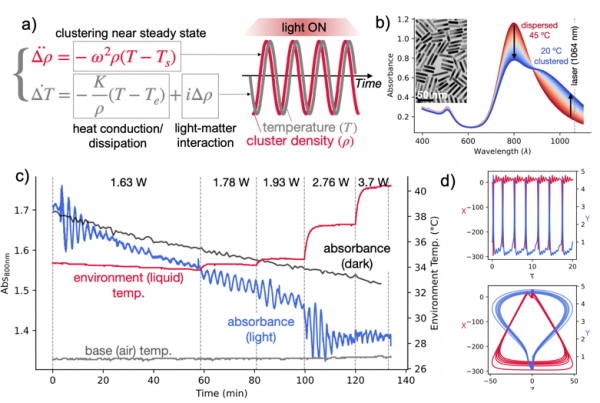Thermoplasmonic self-oscillator based on gold nanoparticles
Self-oscillation is the generation of a periodic change in a system by a non-periodic power source. The ability of a self-oscillator to maintain its frequency enables the conversion of a steady input into a usable oscillating output, a feature present in many biological systems (e.g., neuron firing, heart beating) and synthetic materials (e.g., hydrogels or elastomers).
An international squad of researchers from Spain, Canada, and Croatia, led by Marek Grzelczak (CFM), proposed a new type of self-oscillator. They have introduced a theoretical model, backed by experiments, that revolves around gold nanoparticles that spontaneously come together in clusters. The team observed that when these nanoparticles cluster, they become efficient local heaters due to their strong absorption of light (Figure).

Figure: Thermoplasmonic self-oscillator. A) theoretical model predicting oscillatory clustering of gold nanoparticles. B) Reversibly clustering gold nanorods upon temperature drop. C) oscillatory clustering under different light power density. D) Theoretical prediction of a dynamic system exhibiting attractor-like behaviour.
This leads to an interesting chain of events, where the heated clusters not only disperse again but eventually showed rhythmical clustering and dispersing under constant light illumination. The developed theory predicts that the surface temperature of thermoplasmonic nanoparticles and the number density of their clusters jointly oscillate at frequencies ranging from infrasonic to acoustic values. What’s more, as the researchers delve deeper into the nonlinear aspects, they uncover a whole new world of complexity, with the emergence of dynamic attractors that connect thermoplasmonics to nonlinearity and chaos.
Essentially, this research offers a glimpse into the future of soft robotics and self-propelled machinery down to the scale of nanoparticles, enabling engineering tiny systems that can move on their own, from precise and predictable motions to whimsical and dynamic performances.



